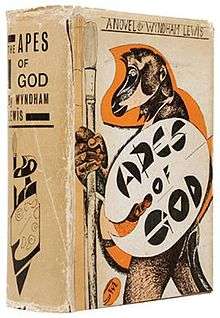The Apes of God
 First edition | |
| Author | Wyndham Lewis |
|---|---|
| Illustrator | Wyndham Lewis |
| Country | United Kingdom |
| Language | English |
| Publisher | The Arthur Press |
Publication date | 1930 |
| Media type | |
| Pages | 625 |
The Apes of God is a 1930 novel by the British artist and writer Wyndham Lewis. It is a satire of London's contemporary literary and artistic scene.
The novel is set in 1926, leading up to the General Strike in May. It has an episodic structure, following a young simpleton called Dan Boleyn from one encounter with the literati to another. Dan follows the directions of an infatuated sixty-year-old albino, Horace Zagreus, who believes him to be a genius. The 'Apes of God' that he meets are imitators of true creators; they are characterised as "prosperous mountebanks who alternately imitate and mock at and traduce those figures they at once admire and hate." (p. 123) Zagreus is himself only the imitator of another character, Pierpoint, who appears to be the origin of all the ideas that circulate in the society depicted in the novel. Pierpoint, though often mentioned and often maligned, never appears in the novel. He is described as 'a painter turned philosopher' (p. 129), a description that could be applied to Lewis himself (his 1927 book, Time and Western Man, contains a great deal of philosophical arguments).
Lewis's "enemies", such as his patron Sidney Schiff (and his wife), Edward Wadsworth (a fellow Vorticist) and John Rodker, along with members of the Bloomsbury Group, including Lytton Strachey, are clearly recognisable under fictional names and are treated with savage humour. The penultimate and longest chapter, 'Lord Osmund's Lenten Party' (over 250 pages), is a satirical account of a fancy-dress party held by three members of the 'Finnian Shaw' family, who are clearly modeled on the Sitwell family, Osbert, Edith and Sacheverell.[1]
The political and cultural 'diagnosis' of England that the novel aspires to make is partly a development of the ideas put forward by Lewis in his 1926 book, The Art of Being Ruled.
References
Further Reading
- Stinson, Emmett. "'The Vortex as Ontology in The Apes of God: Self-Reflexive Satire and Apophaticism'" (PDF). Journal of the Wyndham Lewis Society. Retrieved 29 September 2016.
- Edwards, Paul (1980), 'The Apes of God: Form and Meaning', in Jeffrey Meyers (ed.), Wyndham Lewis: A Revaluation (London: Athlone Press): 133-48.